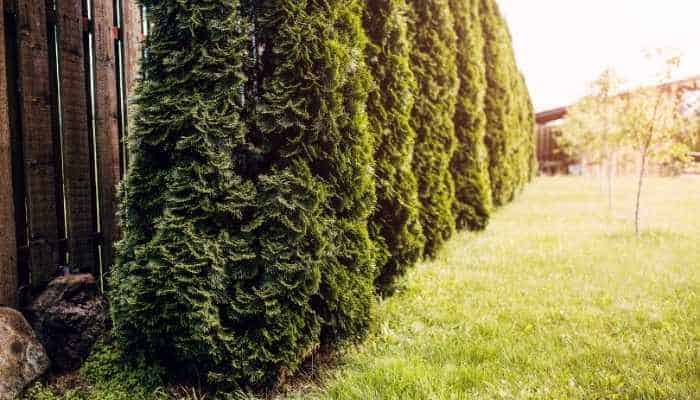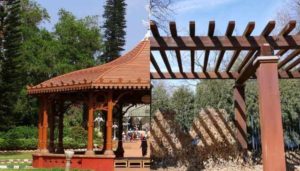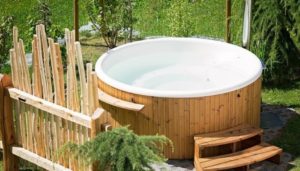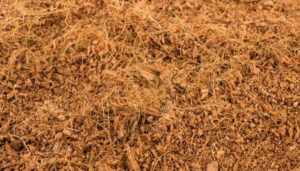While covering how to best provide a natural barrier for privacy to your outdoor living space, I found many good examples of plants that can be used for this. So, I thought I would share them with you.
There are 4 types of plants that are excellent for providing privacy in your backyard:
- Evergreen Trees
- Evergreen Shrubs
- Tall Ornamental Grasses
- Vines
You can take this list and get ideas from it, but I have my favorite picks from these groups of plants, their USDA planting zone, and where they occur naturally listed below. I also go over some tips for planting them, in case you want to learn more. If you do, keep reading!
How Are Evergreen Trees Good for Privacy?
If you have the space, evergreen trees make perfect privacy screens. And because they are evergreen, they provide privacy year-round. You just need to find trees that have a lot of foliage and branches that extend to the ground for the best coverage.
If you want a thick barrier for privacy, you should place your trees so that the branches just barely touch one another. You may want to layer them in tiers with evergreen shrubs and other plants so that they don’t really have to touch. This is a preventative measure in case any of your plants become diseased – so the disease doesn’t easily spread.
These are my picks for the best evergreen trees to incorporate into creating a natural privacy barrier for your backyard:
| PLANT | PLANTING ZONE | NOTES |
|---|---|---|
| Arborvitae “Green Giant” | 3-7 | full sun/partial shade, drought & cold tolerant & more deer-resistant than most arborvitae |
| Southern Magnolia | 6-10 | Partial shade, moderately drought tolerant & deer resistant, large summer blooms |
| White or Blue Spruce | 2-7 | full sun, drought tolerant & deer resistant |
| Juniper trees | 2-9 | full sun/ partial shade, drought tolerant & deer resistant |
If you want something that is deciduous but would also work well for privacy in spring, summer, and early fall, you may want to try a variety of “weeping” trees, that have their foliage hanging well and therefore can provide a barrier for a sightline. Just be sure you’re not purchasing a tree that weeps sap and attracts wasps and yellow jackets.
Are Evergreen Shrubs Good for Privacy?
Whether they are coniferous or broadleaf, evergreen shrubs provide a privacy barrier for sightlines that are lower to the ground than trees. They can be anywhere from 2 – 3 feet (90 cm) in height to 5 – 6 feet(1.5 m). They work well in rows or mixed with other plants to make unique privacy screens.
I’m including more in this category than in others because let’s face it, shrubs are the traditional natural privacy plant. And shrubs can actually grow as tall as some trees, if not taller. Boxwood can get up to 20 feet (cm) high.
If you want a thick barrier for privacy, you should place your shrubs so that the branches just barely touch one another. You may want to layer them in tiers with evergreen trees and other plants so that they don’t really have to touch. Again, if you have the space, this is a preventative measure.
These are my picks for the best evergreen shrubs to incorporate into creating a natural privacy barrier for your backyard:
| PLANT | PLANTING ZONE | NOTES |
|---|---|---|
| Standard Arborvitae | 3-7 | full sun, drought tolerant, NOT deer resistant, can grow tall |
| Saw Palmetto | 8-10 | full sun/shade, drought tolerant & deer resistant, blooms spring & summer, |
| Holly* | 5-9 | full sun/light shade, drought tolerant & deer resistant, fall & winter some have berries |
| Boxwood | 5-9 | full sun, drought tolerant, deer resistant, can grow tall, blooms in spring |
| Yew | 4-7 | Full sun/shade, relatively drought tolerant & deer resistant, produce cones & often winter berries |
| English or Cherry Laurel | 5-9 | full sun/partial shade, drought tolerant, deer resistant, spring blooms, can get tall |
| Red Tip Photinia | 7-9 | full sun/light shade, vibrant leaves, drought tolerant, deer resistant, can grow tall, blooms in spring |
*Holly shrubs may have poisonous berries

Boost’s Tips
You should use columnar trees or upright shrubs to form hedges. Any plants that respond to pruning by growing branches to become denser may make wonderful hedges. To form a continuous hedge, space plants about half their mature width apart to provide full screening when pruned.
Mature width = 10 ft (3 meters) and 10 ÷ 2 = 5
So, plant each shrub 5 ft (1.5 meters) apart.
Tall Ornamental Grasses for Privacy
Ornamental grasses are actually better during certain seasons, and so they might be like deciduous bushes in that during the colder seasons they will die down and not be as great for privacy.
It would be best to plant ornamental grasses as gap-fillers in a tiered and layers privacy barrier with trees and shrubs. No matter how you plant them, be sure to use the taller versions and place them where they can be most effective during the warmer seasons. Also, keep in mind that as some of these ornamental grasses grow, they take up a larger circumference.

Did You Know?
Bamboo is actually grass!
And as such, yes, Bamboo is an invasive plant and an aggressive grower. It grows so fast that if it’s not kept under control it can make your neighbors very upset with you. So it’s best to plant these in containers or when you dig your bed for planting the bamboo, add a root-barrier liner to keep it from spreading.
A lot of people are unaware that there are two kinds of bamboo. Running bamboo will grow via the use of long rhizomes (a continuously growing horizontal underground stem that puts out lateral shoots and roots at intervals) that can make it spread too far. If you plant clumping bamboo, it should have rhizomes that can be kept under control. This is the kind of bamboo best for planting to create a privacy barrier because it can become denser over time.
These are my picks for the best ornamental grasses to incorporate into creating a natural privacy barrier for your backyard:
| PLANT | PLANTING ZONE | NOTES |
|---|---|---|
| Shenandoah switchgrass | 4-9 | full sun, drought tolerant & deer resistant, fall vibrant |
| Feather Reed Grass | 5-9 | full sun/partial shade, drought tolerant & deer resistant |
| Giant Silver Grass (also Pacific Island/ Chinese/ Japanese) | 5-9 | full sun/partial shade, drought tolerant & animal resistant, gets tall |
| Bamboo (clumping) | 5-9 | full sun/partial shade, deer resistant, wind tolerant |
Vines That Provide Privacy
Vines that spread outward as well as upward can provide dense growth by forming a living wall. All it needs is the right guide – like a trellis or lattice wall or old fence to grab hold of. You just need to understand how the vine you choose climbs.
Some have tendrils that wrap around slender things like cables and metal trellises. Others actually cling by digging their stems into a surface, so do better with a stucco wall, wood fencing, or even pallet walls.
Be aware, if vine tendrils wrap around gutters or other surfaces of a house, they can cause serious damage. Also, if a clinging vine happens to grab hold of mortar or the stucco on your actual house, it can cause serious damage. So my first advice is to keep your vines trimmed, controlled, and away from your house.
Vines can be evergreen (keeps the foliage all year round), semi-evergreen (loses some foliage but not always all in the fall and winter months), or deciduous (loses all foliage in fall and winter).

Boost’s Tips
If you want your design to incorporate vines on your actual house, there are ways to prevent damage and keep the vines from hiding pests. I would avoid Ivy (especially English Ivy) as it has really tough clinging roots and it’s a very invasive species.
I would also use trellises or lattices to keep the vines from actually grabbing hold of anything on the structure. You can have these attached to hinges so that when you need to clean behind them or repaint them, the trellis can be pulled away from the house with minimal damage.
Why I wouldn’t want a vine to cling to my house? It will always degrade your masonry, stucco, vinyl siding, or wood siding eventually. Even if the home is brand new. Also, it holds moisture against your house and might be a lovely home for mice and other pests.
These are my picks for the best vines to incorporate into creating a natural privacy barrier for your backyard:
| PLANT | PLANTING ZONE | NOTES |
|---|---|---|
| Jasmine | 6-7 | full sun, drought tolerant & deer resistant, lovely smelling blooms, most are evergreen |
| Wisteria | 5-9 | full sun/partial shade, drought tolerant & deer resistant, takes neglect, beautiful spring & summer blooms, can be coached into a tree, deciduous |
| Clematis | 3-9 | full sun, NOT drought-tolerant or deer resistant, vibrant blooms, great roof cover |
| Virginia Creeper* | 3-9 | partial sun/full shade, very drought-tolerant, NOT animal resistant, fall vibrant leaves, deciduous |
| Honeysuckle | 5-9 | full sun/partial shade, deer resistant, NOT drought-tolerant, spring & summer blooms, semi-evergreen |
*Virginia Creeper has poisonous berries
In Conclusion
Now, my best suggestion would be for you to research which plants are appropriate that come from your local ecosystems. Definitely do not introduce invasive species. However, considering global trade, there will be some mentioned that are not native but can be safely managed.
I also tried to leave out anything that might be poisonous to pets or wildlife in the area. Wanting privacy is important, but you don’t ever want to harm a living creature for your personal needs. However, there were two additions that made the cut that might have poisonous berries, and I indicated those for you.
For the plants that use planters, I would suggest you look for tall containers that you can line up, and then the containers themselves become a decorative partition. This is especially useful around a sitting area or patio, so smaller areas that may need privacy.
If you want to understand how to incorporate these plants into your backyard or any outdoor living space to better enjoy privacy, I do have an article that goes into further detail, just click here to go to that page.






